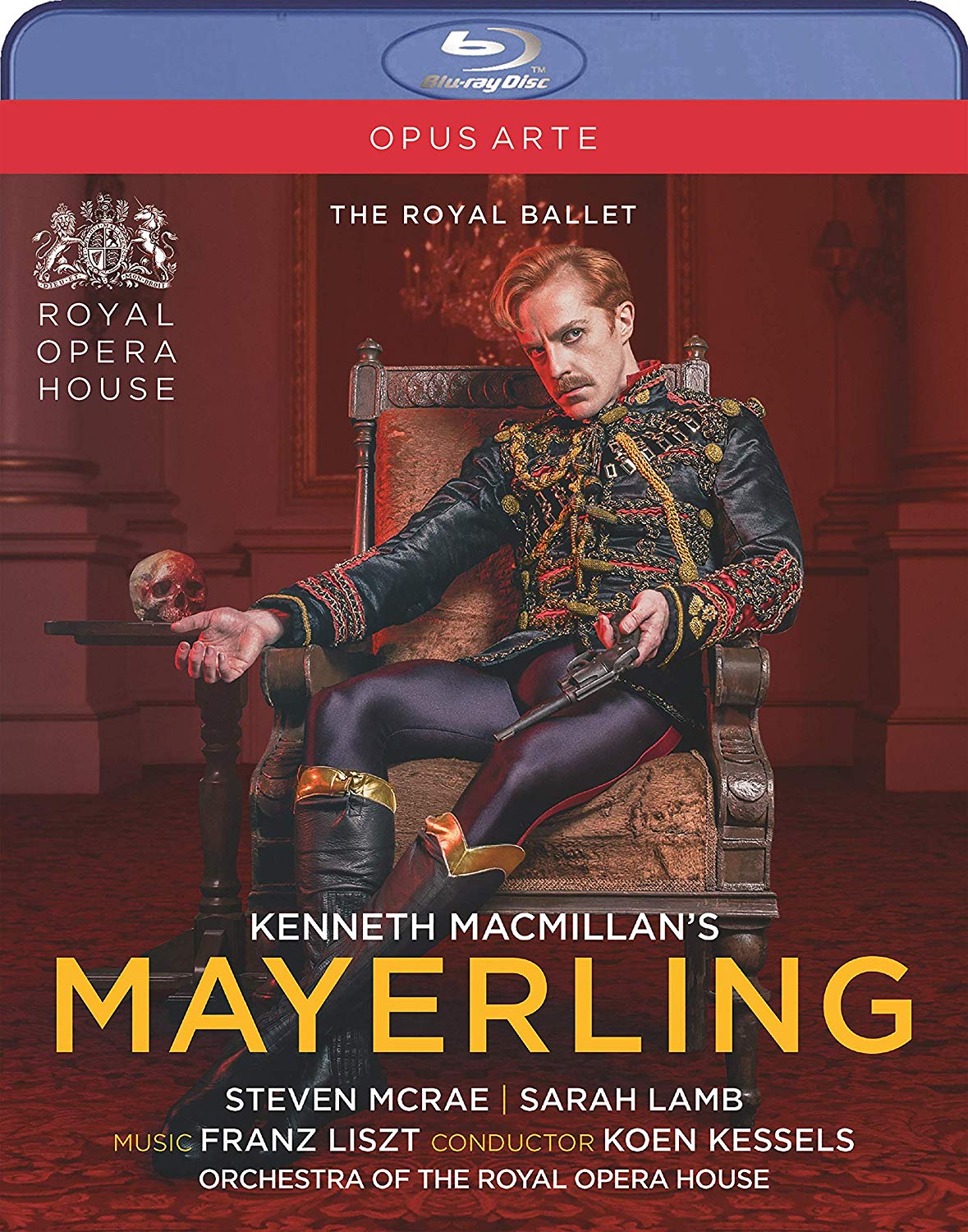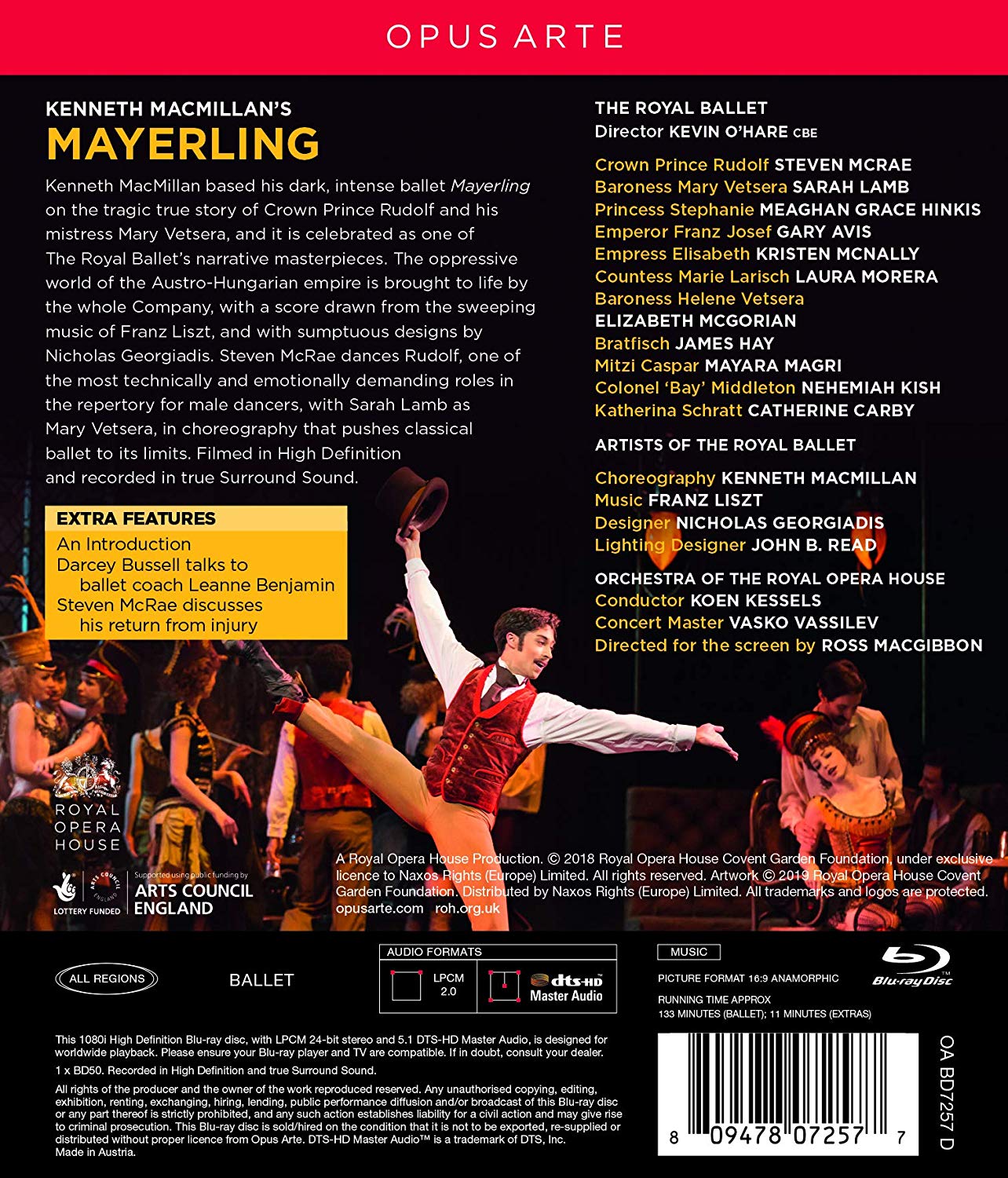

Mayerling ballet. Choreography by Kenneth MacMillan. Music by Franz Liszt as arranged and adapted by John Lanchbery. Performed 2018 at the Royal Opera House. Stars Steven McRae (Crown Prince Rudolf of Austria-Hungary), Sarah Lamb (Baroness Mary Vetsera, Rudolph’s mistress), Meghan Grace Hinkis (Princess Stephanie, Rudolf’s wife), Gary Avis (Emperor Franz Josef of Austria, Rudolf’s father), Kristen McNally (Empress Elisabeth, Rudolf’s mother), Laura Morera (Baroness Marie Larisch, Rudolf’s ex-mistress), Elizabeth McGorian (Baroness Helena Vetsera, Mary’s mother), James Hay (Bratfisch, Rudolph’s driver and entertainer), Ursula Hageli (Archduchcess Sophie, mother of Franz Joesph), Mayara Magri (Mitzi Caspar, a high-class prostitute and Rudolph’s regular mistress), Nehemiah Kish (Colonel ‘Bay’ Middleton, Elizabeth’s lover), Catherine Carby (Katherina Schratt, a friend of the Emperor), Marcelino Sambé, Reece Clarke,Tomas Mock, Calvin Richandson (four Hungarian officers), Paul Stobart (Alfred Grünfeld, a pianist), Alastair Marriott (Count Taafe, Prime Minister of Austria-Hungary), Nicol Edmonds (Count Hoyos, Rudolph's friend), Anna Rose O’Sullivan (Princess Louise, Stephanie's sister), Johnathan Howells (Prince Philipp of Coburg, husband of Princess Louise and friend of Rudolf), Olivia Cotley o(Princess Gisela, Rudolf's elder sister), Camille Bracher (Princess Valerie, Rudolf's younger sister), Ashley Dean (Princess Valerie as a child), Sarah Lamb (Mary Vetsera as a child); David Yudes (Loschek, Rudolf's valet), Thomas Whitehead (Count Larisch), and other artists of the Royal Ballet. Koen Kessels conducts the Orchestra of the Royal Opera House (Concert Master Vasko Vassilev). Designs by Nicholas Georgiadis; scenario by Gillian Freeman; lighting design by John B. Read. Directed for TV by Ross MacGibbon. Released 2019, disc has 5.1 dts-HD Master Audio sound. Grade: A+
This is, of course, the same 2009 show we reviewed several years ago with Ed Watson as Prince Rudolf and Mara Galeazzi as Mary Vetsera. Mayerling is a modern costume/historical ballet first performed in 1978 at the Royal Opera. It has been a big hit at Covent Gardens over the years. Because it is expensive to produce with a huge cast requiring lavish costumes, only a few other companies have tried to mount it. See the PS at the end of this story for a chart showing all the historical characters you meet in this show!
Until recently the 2009 Royal Opera Ballet title was the only HDVD of Mayerling. Now we have this new 2019 production from the Royal with only a handful of dancers carrying over their old roles! This “republication” was done, we think, to give the newer dancers in the Royal Ballet a chance to share in the limelight of being featured in a high-quality video. The sets and costumes seem almost exactly the same. Both versions run about 135 minutes, and both videos were shot by Ross McGibbon.
So then the question for us immediate becomes which version to buy! To learn more about the plot and style of the ballet, see our earlier review. Here we will focus on the differences in the two titles, and we will invest in only a few screenshots.
First we note that the keepcase booklet from 2009 is much nicer and easier to read than the cheapened booklet furnished in 2019. The 2009 booklet has a fine, two page listing of all 48 video chapters that helps a lot in learning who is who and what’s happening in this rich libretto. The PQ in 2009 was plenty good, but it’s some better in 2019, especially in the dark scenes. The SQ in 2019 is modestly but distinctly improved. There is a brief singing part when a guest at a royal celebration performs (as an amateur) an art song with a piano accompaniment. This sounds pretty wobbly and weak on the 2009 disc, but OK in 2019. I would rate the quality of the dancing and acting as about the same in both discs for the supporting stars and the corps members in the group scenes (such as the soldiers and whores in the Prince’s favorite disreputable tavern).
So suddenly we are down to the appearance and acting ability of the stars in the leading roles of Rudolf and Mary Vetsera.
First let’s consider Edward Watson vs. Steven McRae as Rudolf, the hapless Crown Prince of the Hapsburg dynasty. MacMillian wasn’t interested in Rudolf just as a sad story of a ruined life. I think MacMillian viewed his Mayerling as a lesson in Big History in which he depicts the end of an entire epoch. I think he was successful in this, and there is nothing else in the entire ballet literature remotely like this grand achievement. Briefly stated (I know I’m on thin ice) the notion of a “German Reich” breaks down into three periods:
First Reich—The Holy Roman Empire from Charlemagne to 1806. Lasted about 1000 years.
Second Reich—The German/Austrian/Hungarian Empire, in which the Hapsburg dynasty was an important part, which collapsed in 1918 with the end of World War I. The suicide of the Austrian Hapsburg Crown Prince in 1889 was viewed in retrospect as foreshadowing the end of the Second Reich. The Second Reich lasted from 1871 to 1918, or about 53 years.
Third Reich—the end of the Second Reich was a necessary prerequisite for the founding of the Third Reich in 1934 by another Austrian. That Reich lasted 11 years. H’m. The end of the Second Reich was foreshadowed by man and woman committing suicide together. And so also did the Third Reich end.
So the dancer portraying the Rudolf must be capable of expressing the pain not just of one man but of a continent of people suffering over an era. Prince Désiré (from The Sleeping Beauty) need not apply. Ballet dancers are not trained to act like theater or movie stars. So whether a particular dancer can be impressive in the role of Rudolf is mostly a matter of superficial appearance and pure luck.
For the role of Rudolf, Watson was a lucky guy who was (maybe still is) able to register, while dancing, pain, anguish, and madness like no other. I saw Watson in a candid video interview off stage where he appeared to display his real personally—which was that of a perfectly pleasant, happy, friendly, unassuming, content young chap having the time of his life. But in 2017, when I was in London, I saw Watson walking down the street near Covent Garden. His face was in full anguish mode. Had his wife just died in childbirth? More likely he was late to rehearsal, and that’s just the way he looks when he’s upset. During that visit I saw Mayerling at the Royal Opera House with Thiago Soares as Rudolf (Watson was sold out 6 months in advance). Soares is big and intimidating—he’s not a natural for coward Rudolf. But Watson is.
So what about McRae as Rudolf? Alas, he’s a bit short to be a tragic Prince, as you can see in the screenshot below. McRae is on the left, his mother, Empress Elisabeth (Kristen McNally) is center, and Emperor Franz Joseph (Gary Avis) is on the right. (Watson is not tall either, but he doesn’t appear to be short in comparison to the dancers playing his parents in the 2009 version.)
McRae has a scary scowl, but he can’t register vulnerability. He’s one of those little guys who are so dangerous because they know they can whip anyone if they just land the first blow. McRae is probably a more versatile dancer than Watson, but he’s not that great a fit for Rudolf. So for Rudolf, I pick the 2009 Mayerling.
Now let’s consider Mara Galeazzi vs. Sarah Lamb as Mary Vetsera, the 17-year-old girl who became Rudolf’s lover and joined him in death. We focus on 3 famous smoking sex scenes between Mary and Rudolf:
Act II, scene 5—Mary alone (for the first time) with Rudolf to conclude Act 2
Act III, scene 2—Mary joins Rudolf and he asks her to die with him
Act III, scene 3—Mary and Rudolf make love prior to dying
Galeazzi was aging out in 2009, and she was not particularly beautiful. But she was picked for the ferocious athleticism and passion she would bring to the sex scenes. And if you look at pictures of the real Mary Vetsera, you’ll see that Mary was a homely girl. Her prospects for true love were maybe slim, but by dying with Rudolf, her love would become immortal. Galeazzi captures all of this in her portrayal of Mary.
Lamb is now maybe the Queen Bee of all the women dancers trained from scratch at the Royal. She seems to be immortal like a cameo of Venus carved into ancient ivory. Lamb has a an important role in both our 2009 and 2019 Mayerlings! In 2009 she played the role of Countess Larisch, the older cast-off mistress of Rudolf who procures young Mary for him. In 2019, even though she is 10 years older, she still still looks young enough to play the teenager Mary! And Lamb is a bit petite and able to dance the sex scenes with the MacRae without overpowering him. Now let’s consider some screenshots of Lamb at work as Mary.
Mary meets Rudolf when Mary is 13 (I still have trouble getting use to Lamb in a brown wig):
Mary at age 17 arrives, ready for action, at her 1st tryst with Rudolf:
She heard he likes to play with guns:
What! MacGibbon goes long-range for the incredible kiss that ends Act 2:
Next below is the way the kiss ending Act 2 looked in 2009—why did MacGibbon give this up?
Scenes from the double suicide:
McRae goes bug-eyed. But this is not Lamb’s fault!
I have to neutralize my tendency to prefer Galeazzi because I’m used to her. So I wind up rating rating Galeazzi and Lamb about the same (like at the optometrist, I can’t tell which one is better). This leaves me preferring the 2009 disc because I’m a bigger fan of Watson than McRae. I point out that if you are a fan of Lamb, you can have her as Larisch if you buy the 2009 version.
The SQ and PQ are some better in 2019. But the better keepcase booklet in 2009 is also worth considering. Still, I think the acting and dancing of the main leads outweighs other considerations, so I give my nod to 2009. I give the same A+ grade to the 2009 and 2019 versions.
OR
PS: This chart of the historical characters in Mayerling was created by the delightful folks at www.balletbag.com:











